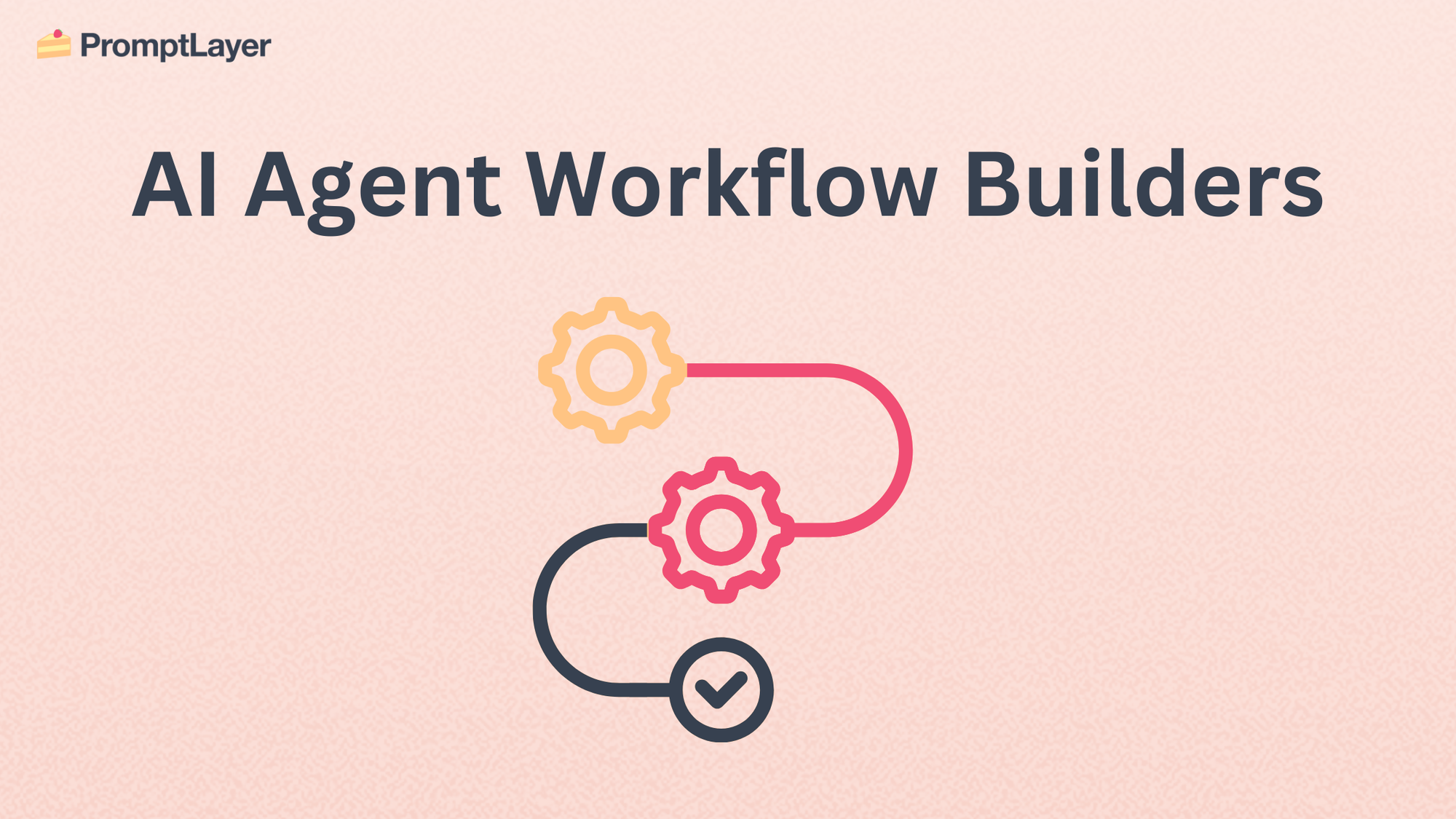Top Agentic Workflow Builders for LLMs

Table of Contents:
- What are Agentic Workflows?
- Key Features of Agentic Workflow Builders
- Top Agentic Workflow Builders
- Top AI Agent Workflow Builder Comparisons
- Use Cases and Applications of Agentic Workflows
Large language models (LLMs) are transforming how we interact with computers and information. Agentic workflows represent the next step in this evolution, tooling LLMs to act autonomously and make decisions to complete complex tasks. This article explores the top agentic workflow builders, examining their features, capabilities, and real-world applications.
What are Agentic Workflows?
Agentic workflows are AI-powered systems that enable LLMs to take initiative, make decisions, and exert control over various stages of a process. They can be viewed as an evolution of traditional workflows, where LLMs and tools were orchestrated through predefined code paths.
Agentic workflows allow LLMs to dynamically direct their own processes and tool usage, maintaining control over how they accomplish tasks. Even basic AI workflows can exhibit agentic behaviors, making decisions and controlling processes at the model level. This agentic behavior empowers LLMs to decide their own control flow to solve complex problems.
Agentic AI workflows differ from Robotic Process Automation (RPA). RPA excels at rule-based processes with structured inputs and outputs, high-volume repetitive tasks, and those requiring minimal exception handling. Agentic AI workflows, conversely, are best suited for processes demanding contextual understanding, judgment, human-AI collaboration, and the ability to navigate multiple applications and systems in complex ways.
The increasing complexity of agentic workflows often necessitates human oversight to ensure they stay on track.
Key Features of Agentic Workflow Builders
Several key features distinguish effective agentic workflow builders:
- Pre-built Components and Abstractions: Modular building blocks for creating AI agents, including design patterns, pre-built workflows, and guidelines, simplify development and reduce setup time.
- Tool Integration: Seamless integration with external tools, databases, APIs, and web services allows agents to access real-time data, execute code, and leverage a wide range of functionalities.
- Memory Management: Robust memory systems allow agents to retain context from past interactions, enabling long-term task execution and continuity.
- Multi-Agent Collaboration: Frameworks that support multiple agents working together, specializing in subtasks within a larger project, enable complex problem-solving.
- Planning and Reasoning: Agents should possess planning capabilities to define goals, sub-goals, sequence actions, identify potential obstacles, and adapt workflows as needed.
- Monitoring and Debugging Tools: Built-in monitoring and debugging features enhance reliability by tracking tasks, troubleshooting issues, and monitoring outputs.
- Governance and Safety: Robust safety features promote ethical AI operation, data security, and compliance with regulations.
Top Agentic Workflow Builders
PromptLayer Workflows
Enables rapid building, launching, and management of AI agents utilizing multiple LLMs and business rules through a visual drag-and-drop interface, simplifying deployment without complex infrastructure management.
Microsoft AutoGen
An open-source framework for multi-agent AI systems designed for complex tasks, featuring agent-to-agent communication, task delegation, tool integration, and code execution capabilities. Supports both autonomous and human-in-the-loop interactions.
LangChain
A modular framework specializing in building LLM-driven agents capable of complex task workflows. Key features include prompt chaining, memory management, and tool integration, enabling dynamic applications and adaptable agent functions.
Hugging Face Transformers Agents 2.0
An open-source framework for agent-based AI workflows, supporting dynamic tool-calling, task-specific adaptability, and secure code execution. Facilitates real-time data retrieval and code execution for high-performance applications.
Swarm by OpenAI
An experimental framework for lightweight multi-agent orchestration, enabling dynamic task handoffs, agent coordination, and execution control. Well-suited for managing complex workflows requiring real-time collaboration.
MetaGPT
An open-source framework for multi-agent collaboration on structured tasks, assigning roles to agents (e.g., product manager, engineer) to simulate a coordinated software team. Uses SOP-based workflows for efficient project execution.
CrewAI
An open-source framework for role-based, collaborative multi-agent systems, supporting autonomous decision-making, task allocation, and inter-agent communication. Ideal for research-oriented applications and large data processing.
Camel
An open-source framework facilitating collaborative, role-based AI agent systems, enabling agents to simulate cooperative human-like interactions. Suited for applications requiring nuanced communication and contextual understanding.
OpenAGI
An open-source AGI research platform designed for multi-step, complex tasks, integrating different models, dynamic model selection, and tool integration. Utilizes task feedback for self-improvement.
Flowise
An open-source, low-code platform for building AI-driven workflows through a drag-and-drop interface. Offers pre-built templates and extensive integration options, ideal for rapid prototyping and deployment.
Top AI Agent Workflow Builder Comparisons
|
Workflow Builder |
User Interface |
Integration Capabilities |
Ease of Use |
Strengths |
Weaknesses |
Key Takeaway |
|
PromptLayer Workflows |
Visual drag-and-drop |
Extensive APIs and tools |
High (drag-and-drop) |
Simple deployment, rapid prototyping |
Limited customization for advanced users |
Great for non-technical users and quick setups. |
|
Microsoft AutoGen |
Open-source, code-based |
Wide tool integration, code execution |
Moderate (requires coding) |
Agent-to-agent communication, human-in-loop |
Complex setup for beginners |
Powerful for multi-agent and complex task workflows. |
|
LangChain |
Modular and code-driven |
Prompt chaining, tools |
Moderate (coding required) |
Dynamic applications, modularity |
Requires coding expertise |
Highly modular and versatile for developers. |
|
Hugging Face Transformers Agents 2.0 |
Code-based, adaptable |
Dynamic tool-calling |
Moderate (technical setup) |
High performance, secure execution |
Technical barriers for non-developers |
Ideal for high-performance, dynamic tasks. |
|
Swarm by OpenAI |
Lightweight and experimental |
Real-time agent collaboration |
High (lightweight) |
Real-time collaboration |
Limited to experimental use cases |
Best for experimental, real-time tasks. |
|
MetaGPT |
SOP-based structured |
Project-focused integrations |
Moderate (task-based setup) |
Efficient project execution |
Focused on structured tasks |
Efficient for software team simulations. |
|
CrewAI |
Role-based collaborative |
Large data processing |
Moderate (collaborative setup) |
Ideal for large data processing |
Less user-friendly for non-research tasks |
Excellent for data-heavy, research applications. |
|
Camel |
Role-based with nuanced communication |
Contextual and nuanced |
Moderate (role-based setup) |
Nuanced inter-agent communication |
Narrower focus on nuanced communication |
Simulates human-like collaboration well. |
|
OpenAGI |
Code-driven with feedback loops |
Dynamic model and tool integration |
Moderate (research-focused) |
Self-improvement via feedback |
Complex for non-research contexts |
Perfect for complex, multi-step research tasks. |
|
Flowise |
Low-code, visual drag-and-drop |
Extensive tool support, templates |
High (visual templates) |
Fast prototyping, extensive integrations |
Limited to simpler workflows |
Low barrier for entry and fast prototyping. |
Use Cases and Applications of Agentic Workflows
Agentic workflows have broad applicability across diverse industries:
- Customer Service & Support: Automating customer inquiries, providing multilingual support.
- Healthcare: Streamlining claims processing, prior authorizations.
- Finance: Real-time fraud detection, high-frequency trading.
- Manufacturing: Predictive maintenance, optimizing supply chains.
- Human Resources: Automating resume screening, answering employee queries.
- Smart Homes: Controlling energy usage, managing security.
- Autonomous Vehicles: Processing environmental data for navigation.
- Content Creation & Marketing: Analyzing user data, creating personalized content.
Conclusion
Agentic workflows are a significant advancement in AI, enabling LLMs to handle complex tasks autonomously. The frameworks discussed here offer powerful tools for building these systems, paving the way for a future where AI agents play an increasingly integral role in various aspects of our lives. As AI continues to evolve, understanding and building agentic systems will become essential for leveraging the full potential of LLMs.
About PromptLayer
PromptLayer is a prompt management system that helps you iterate on prompts faster — further speeding up the development cycle! Use their prompt CMS to update a prompt, run evaluations, and deploy it to production in minutes. Check them out here. 🍰



